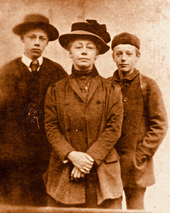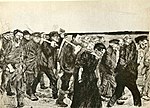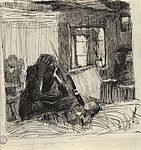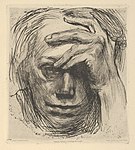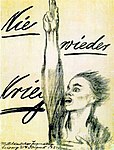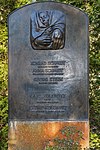Käthe Kollwitz
Käthe Kollwitz (née Schmidt ; * July 8, 1867 in Königsberg (Prussia) , † April 22, 1945 in Moritzburg near Dresden) was a German graphic artist , painter and sculptor and is one of the best-known German artists of the 20th century. With her often serious, sometimes terrifyingly realistic lithographs , etchings , copperplate engravings , woodcuts and sculptures based on personal circumstances and experiences, she developed an independent art style that integrates the influences of expressionism and realism .
Live and act
Käthe Kollwitz was born as the daughter of Katharina (1837–1925) and Karl (1825–1898) Schmidt. Karl Schmidt had initially studied law and then, when he could not find a job with the Prussian state due to his liberal views , became a master mason . Katharina, née Rupp, was a daughter of the free church preacher Julius Rupp . Käthe Kollwitz had Julie, Lisbeth and the later economist and philosopher Conrad Schmidt (1863-1932) as siblings .
She spent her childhood from 1867 to 1885 in Königsberg. Supported by her father, she took lessons from the artist Rudolf Mauer from 1881 . In 1885/86 she went to the so-called women's academy of the Association of Berlin Women Artists . She received lessons from Karl Stauffer-Bern and became acquainted with Gerhart Hauptmann and Arno Holz . During this time, she became interested in the graphic works of Max Klinger , whose etching cycles she had a lasting influence. After a year she returned to Königsberg and was taught by Emil Neide , himself a graduate and later a teacher at the Königsberg Art Academy . She then studied with Ludwig Herterich in Munich until 1890 .

After completing her studies, she lived as an artist in Königsberg for a year before she married her long-time fiancé, the doctor Karl Kollwitz , in June 1891 . Together they moved to a Berlin working-class district, the Prenzlauer Berg district , in a corner house on what was then Weißenburger Straße (today Kollwitzstraße 56A) directly on what was then Wörther Platz (street and square have been named after her since 1947). In 1892 she gave birth to her son Hans , in 1896 her son Peter . From 1898 to 1902/1903 she was a teacher at the women's academy of the Association of Berlin Women Artists.
Kollwitz first attracted general attention by participating in the Great Berlin Art Exhibition in 1898, where she showed her series of etchings A Weavers' Uprising. She had already made the first three sheets of this cycle as lithographs in 1893 after the experience of the world premiere of Gerhart Hauptmann's play Die Weber . Max Liebermann was so impressed that he suggested the young artist for the small gold medal in the same year. However, this was rejected by Kaiser Wilhelm II . He described modern art as gutter art , it was in stark contrast to the then preferred historicism and upper-class salon painting .
She started sculpting in 1910 . She had a close friendship with the Berlin painter Otto Nagel .
In 1914 her son Peter was killed in the First Battle of Flanders . This loss brought them into contact with pacifism and socialists . The sculpture Mourning Parents , created between 1914 and 1932, is dedicated to the fallen son and stands today on the war cemetery in Vladslo , where he was reburied in 1956.
After Karl Liebknecht was murdered , she dedicated a woodcut to him. In her opinion, art has the task of depicting social conditions. She was a member of both the German Association of Artists and the Berlin Secession artists' organization and worked for the International Workers Aid (IAH). In 1926 she signed the “Declaration for the Preservation of Old Berlin” to preserve characteristic street and square images.
She never belonged to any party, but felt herself to be a socialist and supported a call by the International Socialist Fighting League (ISK) for cooperation between the KPD and SPD . In 1933 she was forced to resign from the Prussian Academy of the Arts and relieved of her position as head of the master class for graphics because she had been one of the signatories of the urgent appeal to build a unified workers' front against National Socialism . From 1934 onwards, Kollwitz moved into studio room 210 at Klosterstrasse 75 . In 1936, the Prussian Minister of Culture, Bernhard Rust, had the artist's exhibits removed from the "second anniversary exhibition on the occasion of the 150th anniversary of the academic exhibitions of Berlin sculptors from Schlueter to the present", which amounted to an official exhibition ban. However, she was able to continue working on her old work relatively unmolested in the studio community and completed a large number of drawings, graphics (including the 1937 series of lithographs Death ) and sculptural work there by November 1940 (when she retired for health reasons) . 1937 the cement sculpture Mother with Twins, begun in 1932, or the bronze Die Klage from 1938 to 1940 ).
Her husband died in 1940 and was buried in the family grave in the Friedrichsfelde central cemetery. In 1943 she fled to Nordhausen before the bombing war . In November 1943, her apartment on Weißenburger Strasse was bombed out; numerous graphics, prints and printing plates were destroyed in the process.
In July 1944, Käthe Kollwitz moved to the Rüdenhof in Moritzburg at the invitation of Ernst Heinrich von Sachsen . Here she lived in a corner room on the first floor with a view of Moritzburg Castle and an adjoining room with a balcony. The bedside table, her diary and a bust of Johann Wolfgang von Goethe have been preserved from the furnishings. She died in this apartment on April 22, 1945, a few days before the end of the war and the Nazi regime. Today the building is the Käthe-Kollwitz-Haus Moritzburg , a memorial that commemorates the life and work of the socially committed artist.
Käthe Kollwitz is buried together with some family members in the Berlin central cemetery Friedrichsfelde . Her grave lies in the artist department of the cemetery and is dedicated to the city of Berlin as an honorary grave .
plant
Her work includes etchings , lithographs , woodcuts , drawings and sculptures . It was presented in 1924 by Adolf Heilborn in a monograph (presumably authorized by the artist), which was published by Rembrandt-Verlag Berlin and was reprinted several times. The 5th to 8th thousand, published in 1931, comprised 66 pages and 55 illustrations of the graphic work. The 9th to 10th thousand appeared in 1940 in the series The People's Art Books and had been expanded to 79 pages and by 11 illustrations of sculptures including the group of figures Mourning Parents . In contrast to the previous edition, the text closes in 1940 with the words: “What she once strived for with her warning, plaintive-accusatory posters - it has now been fulfilled in the“ Winter Relief Organization ”of the German people and in the care of all national comrades far beyond any expectation found."
Cycle "A Weavers' Revolt" (1893-1897)
Under the impression of the world premiere of Gerhart Hauptmann's drama Die Weber , Käthe Kollwitz interrupted her work on etchings for Emile Zola's novel Germinal and began to implement her cycle Ein Weberaufstand . However, the etchings and lithographs neither illustrate Hauptmann's drama, nor do they depict the historical weavers' revolt of 1844 on which the drama is based. Kollwitz shows a fictional weaver revolt from the present to draw attention to the misery of the workers. With this cycle she achieved her artistic breakthrough at the Great Berlin Art Exhibition in 1898.
"Peasants' War" cycle (1902 / 1903–1908)
From 1901 to 1908 Käthe Kollwitz worked on her second print cycle, Peasants' War , with which the artist thematized the violent uprising of the peasants against oppression and lawlessness of 1524/1525 and at the same time draws attention to the problems of the proletariat of her time. The series of etchings is based on the story of the Great German Peasants' War by the historian and theologian Wilhelm Zimmermann , which Kollwitz read in the popular edition published in 1891. This three-volume work, published 1841–1843, takes a decisive side in the pre-March sense for the cause of the peasants. The fact that thinkers and publicists such as Friedrich Engels or August Bebel refer to Zimmermann, especially in social democratic circles, shows that the great German Peasants' War of 1524/1525 does not mean a far-flung past for the liberal-socialist environment of Kollwitz, but is topical. While working on the cycle, Kollwitz examines Renaissance masters such as Dürer and Masaccio and modernists such as Daumier and Manet , and experiments with printmaking techniques. Because of the convincing picture solutions that the artist achieved, she was the first woman and graphic artist to be awarded the Villa Romana Prize founded by Max Klinger , the first ever German art prize, even before the cycle was completed.
List of other works

- from 1888: In her earliest works, Kollwitz deals with the question of women . Several drawings on the subject of Gretch from Goethe's Faust are made
- 1913–1915: Creation of the sculpture of lovers
- 1919: Woodcut in memoriam Karl Liebknecht
- After the First World War : cycles of war , proletariat , death and child starvation
- 1924: Poster Never Again War for the Central German Youth Congress in Leipzig
- 1924: Poster Down with the abortion paragraphs ! , published by the KPD
- 1914–1932: Creation of the sculpture Mourning parents in memory of their son Peter, who died in World War I, installed at the German military cemetery in Vladslo . A copy, enlarged by 10 percent, has been standing in the church ruins (memorial) of St. Alban's Church in Cologne since 1959 . A cast was set up on September 20, 2014 in the German war cemetery in Rshew in memory of her grandson who died near Rshew in World War II in 1942, also with the first name Peter.
- 1934: Plastic mother with two children
- 1935/1936: Creation of the bronze relief Rests in the peace of his hands for his own family grave
- 1938 Relief for the gravestone of the couple Franz and Doris Levy at the Jewish cemetery in Bocklemünd , motif: hands grasping and entwining each other. The plaster relief was transferred into the stone by the stonemason Friedrich Bursch.
- 1937–1939: Creation of the sculpture Pietà , also known as mother with dead son .
- 1938–1940: Creation of the bronze relief Die Klage
- 1940–1941: Kollwitz processes the grief for her husband in the small sculpture Farewell
- Around 1940: more serious drawings on these subjects, for example 1943 I stand there digging my own grave
- 1941: Creation of her last lithograph : Seeds shouldn't be ground, the artist's legacy against the death of soldiers and war
- 1943: last small sculpture Two soldiers' wives waiting
Woman praying [also praying girl ], 1892, pencil, ink and Indian ink on paper, Museum of Modern and Contemporary Art, Strasbourg
Not, 1897, ink on paper, Museum of Modern and Contemporary Art, Strasbourg
Grieving parents, 1914–1932, memorial for their son Peter, installation at the military cemetery in Vladslo , Flanders
Mother with two children, 1934, Muschelkalk, installation on the premises of the Pankow District Office in Fröbelstrasse ( Berlin-Prenzlauer Berg )
Collections and museums
Käthe Kollwitz Museum Cologne
The world's largest collection of more than 300 drawings, over 550 prints, all posters and all of the sculptural work is shown in the Käthe Kollwitz Museum in Cologne . It was founded in 1985 by the Kreissparkasse Köln as the first Kollwitz Museum ever and regularly shows exhibitions in thematic contexts (for example Goya , Ernst Barlach , Otto Dix , Henry Moore or Picasso ).
Käthe Kollwitz Museum Berlin
The Käthe-Kollwitz-Museum in Berlin's Fasanenstrasse 24, which has existed since 1986, emerged from the private collection of the painter, gallery owner and art collector Hans Pels-Leusden , who died in 1993 .
Käthe Kollwitz Museum in Koekelare
In Koekelare, Belgium , the Käthe Kollwitz Museum is located at Sint Maartensplein 15. The museum shows a collection of original works of art and tells the story of her son Peter, who is buried nearby in the German military cemetery in Vladslo (Diksmuide). The museum also relates her work to the contemporary art world.
Käthe Kollwitz House Moritzburg
The Käthe Kollwitz House in Moritzburg near Dresden, supported by the Käthe Kollwitz Museum Cologne, is both a museum and an authentic memorial, as Käthe Kollwitz lived and died in this house from 1943 until her death. Today, original graphics, photographs and diary excerpts are shown there. Other exhibitions are historical or focus on artistic techniques ("Imago Mortis - The Image of Death", "History of Lithography").
Important Kollwitz collections
The Kupferstichkabinett Dresden houses one of the oldest Kollwitz collections, today over 200 works by the artist.
The archive of the Akademie der Künste , Berlin, manages, among other things, a large part of Käthe Kollwitz's artistic estate, such as her diaries, numerous letters and other archive material, etching plates and litho stones .
The Kupferstichkabinett Berlin counts works by Käthe Kollwitz among its collection focuses.
The Getty Research Institute in Los Angeles has the Dr. Richard A. Simms Collection the most extensive Kollwitz collection in the USA.
The East Prussian State Museum in Lüneburg has extensive holdings of the artist with the collections of the former Museum City of Königsberg.
honors and awards
In 1906 she was awarded the Villa Romana Prize , the oldest art prize in Germany.
In 1919 Käthe Kollwitz was appointed professor at the Prussian Academy of the Arts . She was the first woman ever to be asked for membership. She was also the first woman to receive the Prussian order Pour le Mérite for sciences and arts on May 29, 1929 .
Two years after the death of Käthe Kollwitz was the Kollwitzstraße (formerly White Straße) in the Berlin district on the occasion of her 80th birthday on July 8, 1947 Berg Prenzlauer , Pankow district named after the artist. Käthe Kollwitz lived and worked in house no. 25 (now 56a) for 52 years from 1891 until she was evacuated in the summer of 1943. In October 1947, the adjacent Wörther Platz was renamed Kollwitzplatz . This also indirectly reminds of her husband Karl Kollwitz , who worked here as a doctor until 1940 and thus shaped the area around the square independently of his wife. Today the square forms the center of the so-called "Kollwitz kiez ".
The monument to Käthe Kollwitz , a bronze picture created by Gustav Seitz based on the artist's last self-portrait in 1938 , has been the center of Berlin's Kollwitzplatz since it was erected in 1961.
In numerous cities streets, squares and schools (see Käthe-Kollwitz-Schule ) are named after the artist. Several parks also bear her name.
Since 1960, the Käthe Kollwitz Prize of the Akademie der Künste, Berlin has been a reminder of Käthe Kollwitz's membership and work in the institution as well as of her resignation in 1933, which was forced by the National Socialists.
The Bundespost first paid tribute to Kollwitz in 1954 in the series "For Welfare - Helpers of Mankind " with the 7 + 3 Pfennig special stamp ( Michel no. 200). In addition, in 1989 the Deutsche Bundespost issued a stamp in honor of Kollwitz as part of the definitive series Women in German History . The stamp had a face value of thirty pfennigs and is registered under the number Michel no. Cataloged in 1488.
The Post of the German Democratic Republic honored Kollwitz with two stamps from the Art Week series. The 25 Pfennig stamps "Never again war" (Michel No. 1609) and the 30 Pfennig stamp "Mother with Child" (Michel No. 1610) represent works of art by Kollwitz.
One of the first new Intercity Express trains ( ICE 4 ) was named after Käthe Kollwitz at the end of October 2017 .
The asteroid Kollwitz (8827) also bears her name.
In December 2017, the Bavarian cabinet decided to include a bust of Käthe Kollwitz in the Walhalla . The bust made by the sculptor Uwe Spiekermann was ceremoniously unveiled on May 29, 2019 in the Walhalla. This makes Käthe Kollwitz the 13th woman to be honored in the Hall of Fame.
The monument to Käthe Kollwitz by Gustav Seitz has been the center of Berlin's Kollwitzplatz since it was erected in 1961 .
Ernst Barlach gave his sculpture Hovering Angel (1927) the face of Käthe Kollwitz. Here the cast in Güstrow Cathedral . Another cast is in the Antoniterkirche in Cologne
Honorary grave of Käthe Kollwitz in the central cemetery Friedrichsfelde in Berlin
Memorial stone in the Schlossallee in Moritzburg with a relief by Etha Richter
Memorial to Käthe Kollwitz by Gustav Seitz in Magdeburg
7 + 3- Pfennig - special stamp of the Deutsche Bundespost (1954) of the series Helfer der Menschheit
First day cover 1970 with portrait, signature and GDR postage stamps (motifs: the works Never Again War and Mother with Child in Her Arm )
literature
Testimonials
- The diaries 1908–1943. Edited by Jutta Bohnke-Kollwitz. Siedler, Berlin 1989, ISBN 3-88680-251-5 ; at the same time GDR edition: Akademie-Verlag. Extended new edition btb, Munich 2007, ISBN 978-3-442-73683-6 .
- Letters to the son 1904–1945. Edited by Jutta Bohnke-Kollwitz. Siedler, Berlin 1992, ISBN 3-88680-250-7 .
- Out of my life. A will of the heart. Drawings by Käthe Kollwitz, foreword by Hans Kollwitz. First edition. Paul List , Munich 1957 a. ö .; again: Herder, Freiburg 1992, ISBN 3-451-04105-7 ; last: 2006, ISBN 3-451-05757-3 .
- Diary sheets and letters . Published by Hans Kollwitz, Berlin 1948. Other selected editions of the diaries and letters in various publishers.
Secondary literature
- Andreas Benz : “There is also a life before death.” To Käthe Kollwitz. In: The survivor: Three productions to overcome a trauma. European Publishing House , Hamburg 1997, ISBN 3-434-46233-3 .
- Brigitte Birnbaum : Kathusch. Children's book publisher, Berlin 1986, ISBN 3-358-00733-2 .
- Lotte Bormuth : Käthe Kollwitz: From the life of a committed artist , Francke Verlag, Marburg 2006, ISBN 978-3-86122-804-2 .
- Maria Derenda: Käthe Kollwitz and the caesura of 1933. A representation based on her personal reports. In: Wolfgang Ruppert (Ed.), Artists under National Socialism. "German Art", art politics and the Berlin Art School , Böhlau Verlag, Cologne / Weimar / Vienna 2015, ISBN 978-3-412-22429-5 , pp. 245–260.
- Maria Derenda: Artistic work in self-testimony by Käthe Kollwitz (1867–1945). In: Garstenauer, Therese; Hübel, Thomas; Löffler, Klara (Ed.): Work in the curriculum vitae. Negotiations of (employment) biographical normality , transcript, Bielefeld 2016, ISBN 978-3-8376-3373-3 , pp. 53–73.
- Gudrun Fritsch (Ed.): Käthe Kollwitz and Russia. An elective affinity. Seemann, Leipzig 2013, ISBN 978-3-86502-301-8 .
- Gerda Breuer , Julia Meer (Ed.): Women in Graphic Design. Jovis, Berlin 2012, ISBN 978-3-86859-153-8 , pp. 52, 490.
- Gudrun Fritsch, Josefine Gabler, Helmut Engel : Käthe Kollwitz. be.bra Wissenschaft verlag, Berlin 2013, ISBN 978-3-95410-014-9 .
- Martin Fritsch (Ed.): Käthe Kollwitz. Drawing, graphics, plastic. Inventory catalog of the Käthe Kollwitz Museum Berlin. Seemann, Leipzig 1999, ISBN 3-86502-036-4 .
- Martin Fritsch (Ed.): Homage to, Homage to Käthe Kollwitz. Seemann, Leipzig 2005, ISBN 3-86502-117-4 .
- Lorenz Grimoni (Ed.): Käthe Kollwitz: Königsberger Years. Influences and Effects. Verlag der Kunst, Husum 2007, ISBN 978-3-86530-100-0 .
- Ludwig Kämmerer: Käthe Kollwitz. Stylus art and worldview. Dresden 1923.
- August Klipstein : Käthe Kollwitz: Directory of the graphic work. Galerie St. Etienne, New York 1955; (English edition: The Graphic Work of Käthe Kollwitz: Complete Illustrated Catalog. Galerie St. Etienne, New York 1955.)
- Alexandra von dem Knesebeck: Käthe Kollwitz. Catalog raisonné of the graphic. Revision of the directory by August Klipstein , published in 1955. 2 volumes. Bern 2002, ISBN 3-85773-040-4 .
- Marina Linares : Käthe Kollwitz - An Aesthetic in the Field of Tension Between Private (Experience) Life and Political Agitation , Expressionism, Neofelis Verlag Berlin 4/2016, pp. 106–119, ISSN 2363-5592
- Lenka von Koerber : Experiences with Käthe Kollwitz. Berlin 1957.
- Hildegard Reinhardt: Sella Hasse and Käthe Kollwitz in comparison. Two socially critical artists at the beginning of classical modernism. In: Berlinische Galerie (ed.): Profession without tradition. 125 years of the Association of Berlin Women Artists. Berlin 1992.
- Fritz Schmalenbach : Käthe Kollwitz. Langewiesche publishing house , Königstein i. Ts. 1965, 2014 (series = Die Blauen Bücher ), German / English, ISBN 978-3-7845-2672-0 .
- Werner Schmidt (Hrsg.): The Kollwitz Collection of the Dresden Kupferstichkabinett. Graphics and drawings 1890–1912. DuMont, Cologne 1988, ISBN 3-7701-2297-6 .
- Yvonne Schymura: Käthe Kollwitz 1867-2000. Biography and reception history of a German artist. Klartext, Essen 2014, ISBN 978-3-8375-1035-5 .
- Yvonne Schymura: Käthe Kollwitz. Love, war and art; a biography. Beck, Munich 2016, ISBN 978-3-406-69871-2 .
- Ute Seiderer: Between Minor Sculpture and Promethean Creativity. Käthe Kollwitz and Berlin's Women Sculptors in the Discourse on Intellectual Motherhood and the Myth of Masculinity. In: Christiane Schönfeld (Ed.): Practicing Modernity. Female Creativity in the Weimar Republic. Königshausen & Neumann , Würzburg 2006, ISBN 3-8260-3241-1 , pp. 89–119.
- Ursula Trüper: “Unfortunately I was a girl.” About Käthe Kollwitz. Edition Nautilus, Hamburg 2001, ISBN 3-89401-370-2 .
- Kollwitz, Käthe, b. Schmidt in: Hans Vollmer (Hrsg.): General Lexicon of Fine Artists of the XX. Century. Third volume (KP) , EA Seemann, Leipzig 1999, (study edition), ISBN 3-363-00730-2 , pp. 90f.
- Irmgard Wirth: Kollwitz, Käthe, née Schmidt. In: New German Biography (NDB). Volume 12, Duncker & Humblot, Berlin 1980, ISBN 3-428-00193-1 , p. 470 f. ( Digitized version ).
- Yury Winterberg and Sonya Winterberg : Kollwitz: the biography. Bertelsmann, Munich 2015, ISBN 978-3-570-10202-2 .
-
Käthe Kollwitz Museum Cologne (ed.), Annette Seeler (author): Käthe Kollwitz: Die Plastik. Catalog raisonné. Hirmer, Munich 2016, ISBN 978-3-7774-2557-3 .
- supplementary online catalog : Hirmer, Munich 2016.
- Kathleen Krenzlin (ed.): Käthe Kollwitz and Berlin. A search for clues. Deutscher Kunstverlag, Berlin 2017, ISBN 978-3-422-07424-8 .
- Käthe-Kollwitz-Museum Berlin (ed.), David Dambitsch (author): "Power is what I need ..." Käthe Kollwitz and her family. Audio book. Berlin 2020.
Exhibition catalogs
- Käthe Kollwitz. Masterpieces of drawing. Käthe Kollwitz Museum Cologne. DuMont, Cologne 1995, ISBN 3-7701-3461-3 .
- Gudrun Fritsch, Pay Matthis Karstens (ed.): Reminder and Temptation. The image worlds of war by Käthe Kollwitz and Kata Legrady . Exhibition catalog Käthe-Kollwitz-Museum Berlin. Berlin 2014, ISBN 978-3-86502-329-2 .
- Hannelore Fischer, Alexandra von dem Knesebeck (ed.): "Paris enchanted me ..." Käthe Kollwitz and French modernism. Monograph on the special exhibition in the Käthe Kollwitz Museum Cologne. Hirmer, Munich 2010, ISBN 978-3-7774-3041-6 .
- Käthe-Kollwitz-Museum Berlin (Ed.): Käthe Kollwitz and her friends. Lukas Verlag, Berlin 2017, ISBN 978-3-867-322-829 .
Settings
- David Philip Hefti : Monumentum - music for string sextet Inspired by Käthe Kollwitz's grieving parents . Edition Kunzelmann, 2014, ISMN 979-0-2062-0238-4.
Movie
- Kollwitz - a life of passion . Documentary, Germany, 2016, 51:55 min., Book: Sonya Winterberg , directors: Henrike Sandner and Yury Winterberg , production: LOOKSfilm , rbb , arte , first broadcast: 4th July 2017 on arte, summary by ARD , review .
Web links
- Literature by and about Käthe Kollwitz in the catalog of the German National Library
- Works by and about Käthe Kollwitz in the German Digital Library
- Newspaper article about Käthe Kollwitz in the 20th century press kit of the ZBW - Leibniz Information Center for Economics .
- Search for Käthe Kollwitz in the SPK digital portal of the Prussian Cultural Heritage Foundation
- Works and biography - Galerie Ludorff
- Lots of graphics - rogallery.com
- Käthe Kollwitz on kunstaspekte.de
- Käthe Kollwitz archive in the archive of the Academy of Arts, Berlin
Biographies
- The artist - timeline on kollwitz.de
- Lutz Walther, Levke Harders: Käthe Kollwitz. Tabular curriculum vitae in the LeMO ( DHM and HdG )
- Kollwitz biography on Shoa.de
- Short biography of the German Resistance Memorial Center
- Joey Horsley: Käthe Kollwitz. In: FemBio. Women's biography research (with references and citations).
Museums
Individual evidence
- ^ Association chronicle: 1867–1893 establishment . In: Association of Berlin Women Artists 1867 e. V. , accessed on January 6, 2018.
- ^ Werner Schumann: The great Zille album , 1957, DNB 455818665 .
- ^ Norbert Schulz: (Weber) strike: detailed view. In: DHM . Retrieved January 6, 2018 .
- ↑ Harald Olbrich (Ed.): Lexicon of Art. Architecture, fine arts, applied arts, industrial design, art theory. Volume III: Greg – conv. EA Seemann Verlag, Leipzig 2004, ISBN 3-86502-084-4 , p. 817.
- ↑ German loss lists (Prussian loss list No. 520) of May 3, 1916, p. 12292: Reserve Infantry Regiment No. 207. Kollwitz [not Bollirtz], Peter (4th company) - Berlin - fallen. (already reported in VL No. 93 of December 4, 1914, p. 3306, as "Krgsfreiw. Peter Bollirtz")
- ^ Members since 1903. Full members of the German Association of Artists . In: Deutscher Künstlerbund e. V. , accessed on January 6, 2018.
- ↑ stadtbild-berlin.de
- ↑ see fig. Pp. 114 to 119, studio photos p. 182, in: Ateliergemeinschaft Klosterstrasse - Berlin 1933–1945. Artists in the time of National Socialism , Academy of the Arts (Berlin) , Edition Hentrich, Berlin 1994, ISBN 3-89468-134-9 .
- ^ Joachim Hoffmann : Berlin-Friedrichsfelde. A German national cemetery. Cultural history guide .
- ^ Adolf Heilborn: Käthe Kollwitz . In: The People's Art Books . 9-10 Thousand edition. Rembrandt-Verlag, Berlin 1940, p. 77 .
- ^ The picture Not from it in large format at Norbert Berghof (Red.): Picture folder Art in the persecution: Degenerate Art - Exhibition 1937 in Munich . 18 examples, also supplement: life data and personal testimonials, both Neckar, Villingen 1998.
- ↑ www.kollwitz.de, Tour Room 1 Accessed on August 26, 2018.
- ↑ See Hannelore Fischer for the Käthe Kollwitz Museum Cologne (ed.): Aufstand! Renaissance, Reformation and Revolt in the work of Käthe Kollwitz. Monograph on the cycle “Peasants' War”. From Annette Seeler. Wienand, Cologne 2017, ISBN 978-3-86832-382-5 .
- ↑ Bernd Ulrich: Memorial: bronze sculpture for the war victims. In: Deutschlandfunk , November 14, 2013.
- ↑ Poster Down with the abortion paragraphs! and Explanation of Abortion Section 218. In the LeMO
- ^ Letter from the Volksbund Deutsche Kriegsgräberfürsorge dated March 31, 2014 to its members.
- ↑ a b Käthe Kollwitz - The sculpture. Catalog raisonné . In: Käthe Kollwitz Museum Köln , accessed on January 6, 2018.
- ^ Käthe Kollwitz Museum Sint Maartensplein 15, Box: B. 8680 Koekelare: Käthe Kollwitz Museum. Retrieved July 12, 2019 .
- ↑ www.getty.edu; accessed on August 26, 2018
- ↑ accessed on February 26, 2020
- ↑ The Order Pour le Mérite for Science and the Arts: The Members of the Order Volume II (1882–1952) , Gebr. Mann-Verlag, Berlin 1978, p. 350.
- ↑ Michael Bienert: "Memories filled all rooms." Apartments and neighbors of the Kollwitz family in Weißenburger Straße 25 . In: Kathleen Krenzlin (ed.): Käthe Kollwitz and Berlin. A search for clues . Deutscher Kunstverlag, Berlin 2017, ISBN 978-3-422-07424-8 , pp. 79–95.
- ^ Academy of the Arts, Berlin and Käthe Kollwitz Museum Cologne (ed.): Kollwitz rethink. Käthe Kollwitz Prize Winner of the Akademie der Künste, Berlin, Berlin 2017. ISBN 978-3-88331-225-5 .
- ↑ The ICE 4 names have been determined. The jury selected the top 25 names for the upcoming train baptisms. ( Memento from October 28, 2017 in the Internet Archive ). In: DB Inside Bahn , October 27, 2017.
- ↑ Käthe Kollwitz and Max Planck come to the Walhalla. Süddeutsche Zeitung , December 19, 2017, accessed on August 21, 2020 . .
- ↑ SZ of May 29, 2019. Süddeutsche Zeitung , May 29, 2019, accessed on August 14, 2020 . .
- ↑ weekly newspaper of June 1, 2019 ; accessed on June 2, 2019.
- ↑ Review by Peter Sager : The suffering of people , in: Die Zeit , October 20, 1989, review section. Reprinted in: Die Zeit. World and cultural history. Volume 13, ISBN 3-411-17603-2 , pp. 547-556.
- ↑ The letters to Hans are her largest complete letter delivery.
- ↑ Own publication
| personal data | |
|---|---|
| SURNAME | Kollwitz, Käthe |
| ALTERNATIVE NAMES | Schmidt, Käthe (maiden name) |
| BRIEF DESCRIPTION | German artist |
| DATE OF BIRTH | July 8, 1867 |
| PLACE OF BIRTH | Königsberg (Prussia) |
| DATE OF DEATH | April 22, 1945 |
| Place of death | Moritzburg (Saxony) |

